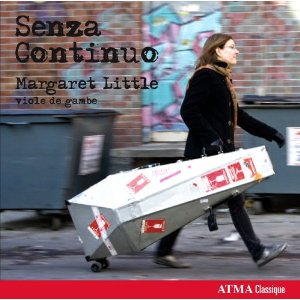I’ve never heard a bad recording involving viola da gambist Margaret Little. If you care anything about early music you will know her from a steady stream of excellent recordings she has made with a number of Montréal-based ensembles including Studio de Musique ancienne dé Montréal, Les Boréades and others for the ATMA Classique label. She’s probably best known as one half (with gambist Susie Napper) of the superb duo Les Voix humaines. On Senza Continuo Little goes solo in a program of French, Italian and English music from the renaissance and early baroque.
There are few instruments with as much expressive power and pure tonal beauty as the viola da gamba and since it could play both melody and harmony, there is some fine solo repertoire for the instrument. Little has chosen some real beauties for this recording. As would be expected there’s music by two French composers closely associated with the instrument: Jean De Sainte-Colombe and Marin Marais. Napper and Little have recorded Sainte-Colombe’s seminal Concerts á deux violes égales, so it’s especially pleasing to hear her in three of his solo works (he wrote nearly 177 solo works for the gamba). This is music that pushes the instrument (and soloist) to expressive and technical limits and Little excels. Little also makes the most of the pieces by Marais which were apparently intended to be played with basso continuo (the continuo parts were delayed at Marais’ printer) but played solo here. The Italian music – ricercars by Aurelio Virgiliano and Giovanni Bassano – require no small measure of technical flash and once again Little is up to the challenge. In some ways a set of pieces from Tobias Hume’s First Book of Ayres is best of all. Hume was one of the first and finest composers to write for the gamba as a purely solo instrument and the seven dance movements heard here really showcase his best efforts.
As I said earlier, Little has technique aplenty but also an almost preternatural gift for channeling the composer’s thoughts and communicating them through the instrument, for me this was particularly noticeable in the Marais and Hume. The recording quality really captures the natural voice of strings and wood and makes for some of the most intimately realistic sound I’ve heard.
Here’s a video from ATMA Classique
The sublime Les Voix humaines
